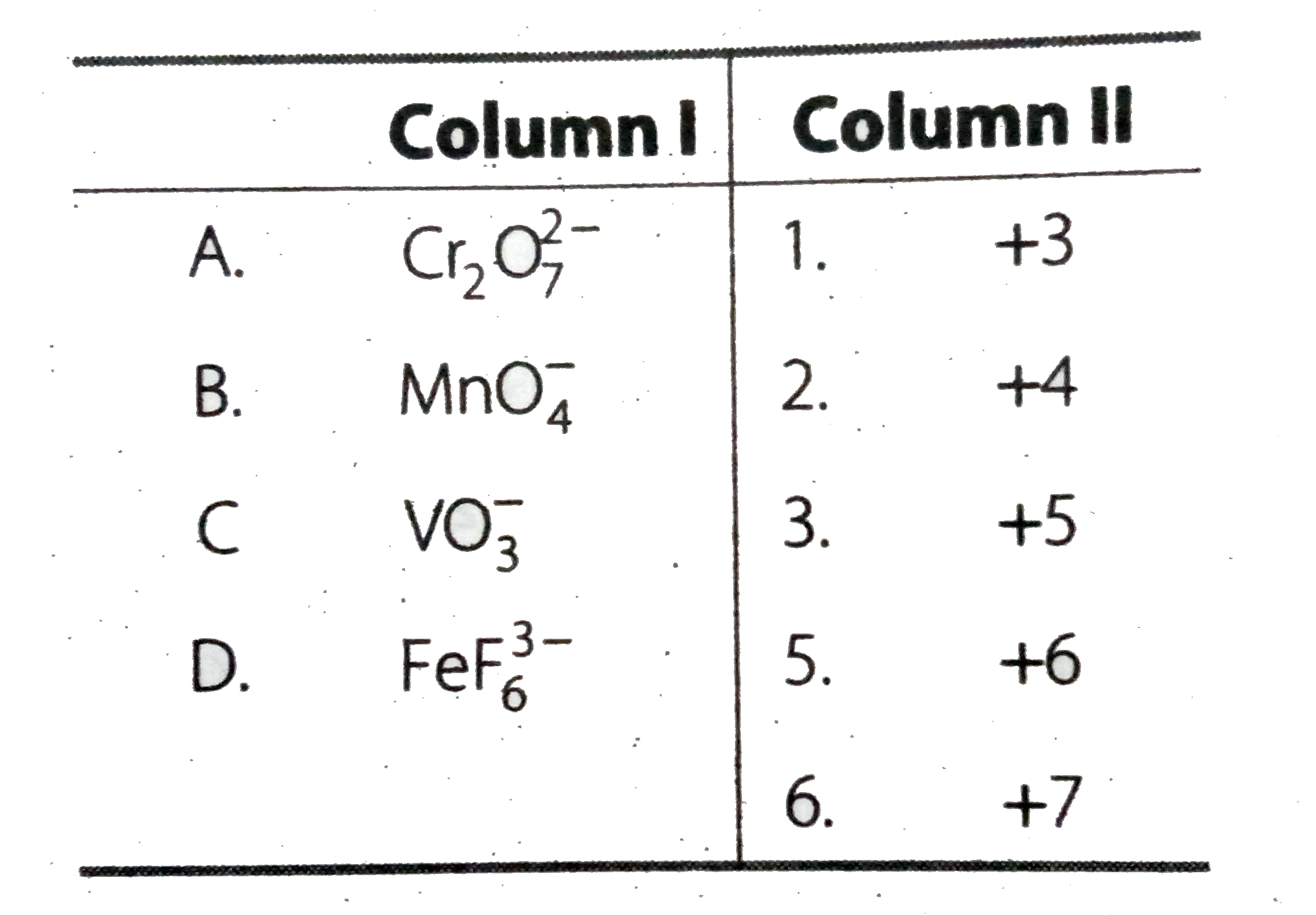Match Column I with Column II for the oxidation states of the central atoms .
Column IColumn II(i)Cr2O2−7(a)+3(ii)MnO−4(b)+4(iii)VO−3(c)+5(iv)FeF3−6(e)+7
The correct Answer is:(i)−(d);(ii)−(e);(iii)−(c);(iv)−(a)
To solve the problem of matching the oxidation states of the central atoms in Column I with their corresponding values in Column II, we will calculate the oxidation states for each compound step by step.
Step 1: Calculate the oxidation state of Chromium in Cr2O2−7
1. Let the oxidation state of Chromium (Cr) be x.
2. There are 2 Chromium atoms, so the contribution from Chromium is 2x.
3. Oxygen has an oxidation state of -2, and there are 7 Oxygen atoms, contributing 7×(−2)=−14.
4. The overall charge of the dichromate ion Cr2O2−7 is -2.
Now, we can set up the equation:
2x−14=−2
5. Solving for x:
2x=12⟹x=6
Thus, the oxidation state of Chromium in Cr2O2−7 is +6.
Step 2: Calculate the oxidation state of Manganese in MnO−4
1. Let the oxidation state of Manganese (Mn) be x.
2. The contribution from Mn is x.
3. Again, Oxygen has an oxidation state of -2, and there are 4 Oxygen atoms, contributing 4×(−2)=−8.
4. The overall charge of the permanganate ion MnO−4 is -1.
Setting up the equation:
x−8=−1
5. Solving for x:
x=7
Thus, the oxidation state of Manganese in MnO−4 is +7.
Step 3: Calculate the oxidation state of Vanadium in VO−3
1. Let the oxidation state of Vanadium (V) be x.
2. The contribution from V is x.
3. Oxygen has an oxidation state of -2, and there are 3 Oxygen atoms, contributing 3×(−2)=−6.
4. The overall charge of the vanadate ion VO−3 is -1.
Setting up the equation:
x−6=−1
5. Solving for x:
x=5
Thus, the oxidation state of Vanadium in VO−3 is +5.
Step 4: Calculate the oxidation state of Iron in FeF3−6
1. Let the oxidation state of Iron (Fe) be x.
2. The contribution from Fe is x.
3. Fluorine has an oxidation state of -1, and there are 6 Fluorine atoms, contributing 6×(−1)=−6.
4. The overall charge of the hexafluoroferrate ion FeF3−6 is -3.
Setting up the equation:
x−6=−3
5. Solving for x:
x=3
Thus, the oxidation state of Iron in FeF3−6 is +3.
Summary of Results
- Cr2O2−7 → +6
- MnO−4 → +7
- VO−3 → +5
- FeF3−6 → +3
Final Matching
Now we can match the results with Column II:
- (i) Cr2O2−7 → (a) +6
- (ii) MnO−4 → (e) +7
- (iii) VO−3 → (c) +5
- (iv) FeF3−6 → (b) +3
Final Answer
- (i) → (a)
- (ii) → (e)
- (iii) → (c)
- (iv) → (b)
2. There are 2 Chromium atoms, so the contribution from Chromium is 2x.
3. Oxygen has an oxidation state of -2, and there are 7 Oxygen atoms, contributing 7×(−2)=−14.
4. The overall charge of the dichromate ion Cr2O2−7 is -2.
2x−14=−2
5. Solving for x:
2x=12⟹x=6
Thus, the oxidation state of Chromium in Cr2O2−7 is +6.
2. The contribution from Mn is x.
3. Again, Oxygen has an oxidation state of -2, and there are 4 Oxygen atoms, contributing 4×(−2)=−8.
4. The overall charge of the permanganate ion MnO−4 is -1.
x−8=−1
5. Solving for x:
x=7
Thus, the oxidation state of Manganese in MnO−4 is +7.
2. The contribution from V is x.
3. Oxygen has an oxidation state of -2, and there are 3 Oxygen atoms, contributing 3×(−2)=−6.
4. The overall charge of the vanadate ion VO−3 is -1.
x−6=−1
5. Solving for x:
x=5
Thus, the oxidation state of Vanadium in VO−3 is +5.
2. The contribution from Fe is x.
3. Fluorine has an oxidation state of -1, and there are 6 Fluorine atoms, contributing 6×(−1)=−6.
4. The overall charge of the hexafluoroferrate ion FeF3−6 is -3.
x−6=−3
5. Solving for x:
x=3
Thus, the oxidation state of Iron in FeF3−6 is +3.
- MnO−4 → +7
- VO−3 → +5
- FeF3−6 → +3
- (ii) MnO−4 → (e) +7
- (iii) VO−3 → (c) +5
- (iv) FeF3−6 → (b) +3
- (ii) → (e)
- (iii) → (c)
- (iv) → (b)
Topper's Solved these Questions
- BOOK - MODERN PUBLICATIONCHAPTER - REDOX REACTIONS EXERCISE - NCERT FILE Solved (NCERT - Exemplar Problems) (Assertion and Reason Type Questions)4videos
REDOX REACTIONS
- BOOK - MODERN PUBLICATIONCHAPTER - REDOX REACTIONS EXERCISE - NCERT FILE Solved (NCERT - Exemplar Problems) (Long Answer Questions )6videos
REDOX REACTIONS
- BOOK - MODERN PUBLICATIONCHAPTER - REDOX REACTIONS EXERCISE - NCERT FILE Solved (NCERT - Exemplar Problems) (Short Answer Questions)10videos
REDOX REACTIONS
- BOOK - MODERN PUBLICATIONCHAPTER - ORGANIC CHEMISTRY: BASIC PRINCIPLES AND TECHNIQUESEXERCISE - (Competition File) MULTIPLE CHOICE QUESTIONS ( based on the given. passage/comprehension )8videos
ORGANIC CHEMISTRY: BASIC PRINCIPLES AND TECHNIQUES
- BOOK - MODERN PUBLICATIONCHAPTER - S-BLOCK ELEMENTS ( ALKALI AND ALKALINE EARTH METALS ) EXERCISE - UNIT PRACTICE TEST13videos
S-BLOCK ELEMENTS ( ALKALI AND ALKALINE EARTH METALS )
Similar Questions
Knowledge Check
- Question 1 - Select One
Match the Column I with II Column II
AA B C D1 2 3 4BA B C D3 1 2 4CA B C D4 1 2 3DA B C D4 3 2 1 - Question 2 - Select One
Match the Column I and Column II.,B
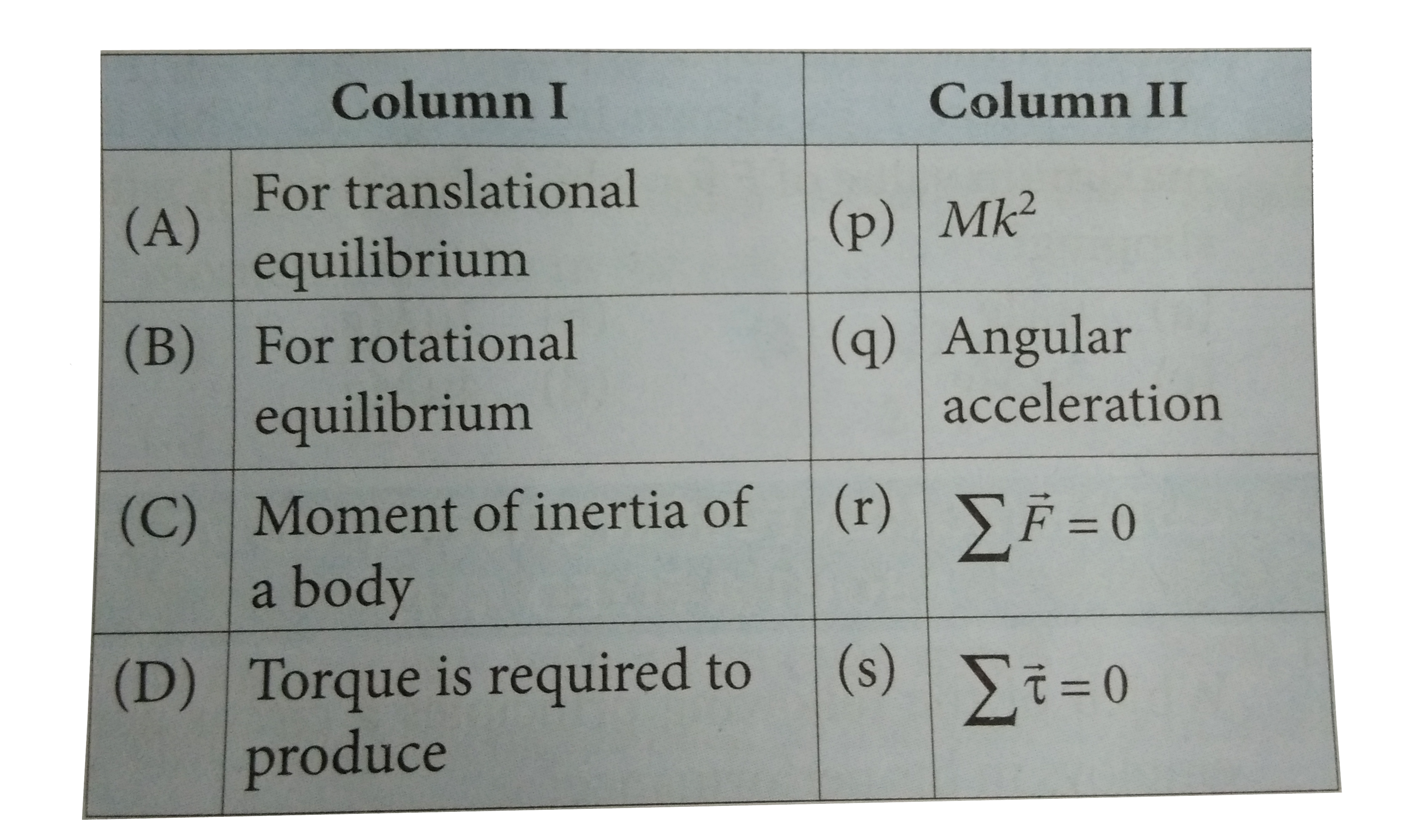 AA-p, B-q, C-r, D-sBA-q, B-r, C-s. D-pCA-r, B-q, C-p, D-pDA-r, B-s, C-p, D-q
AA-p, B-q, C-r, D-sBA-q, B-r, C-s. D-pCA-r, B-q, C-p, D-pDA-r, B-s, C-p, D-q - Question 3 - Select One
Match the column I with Column II and Column III ltbvrgt
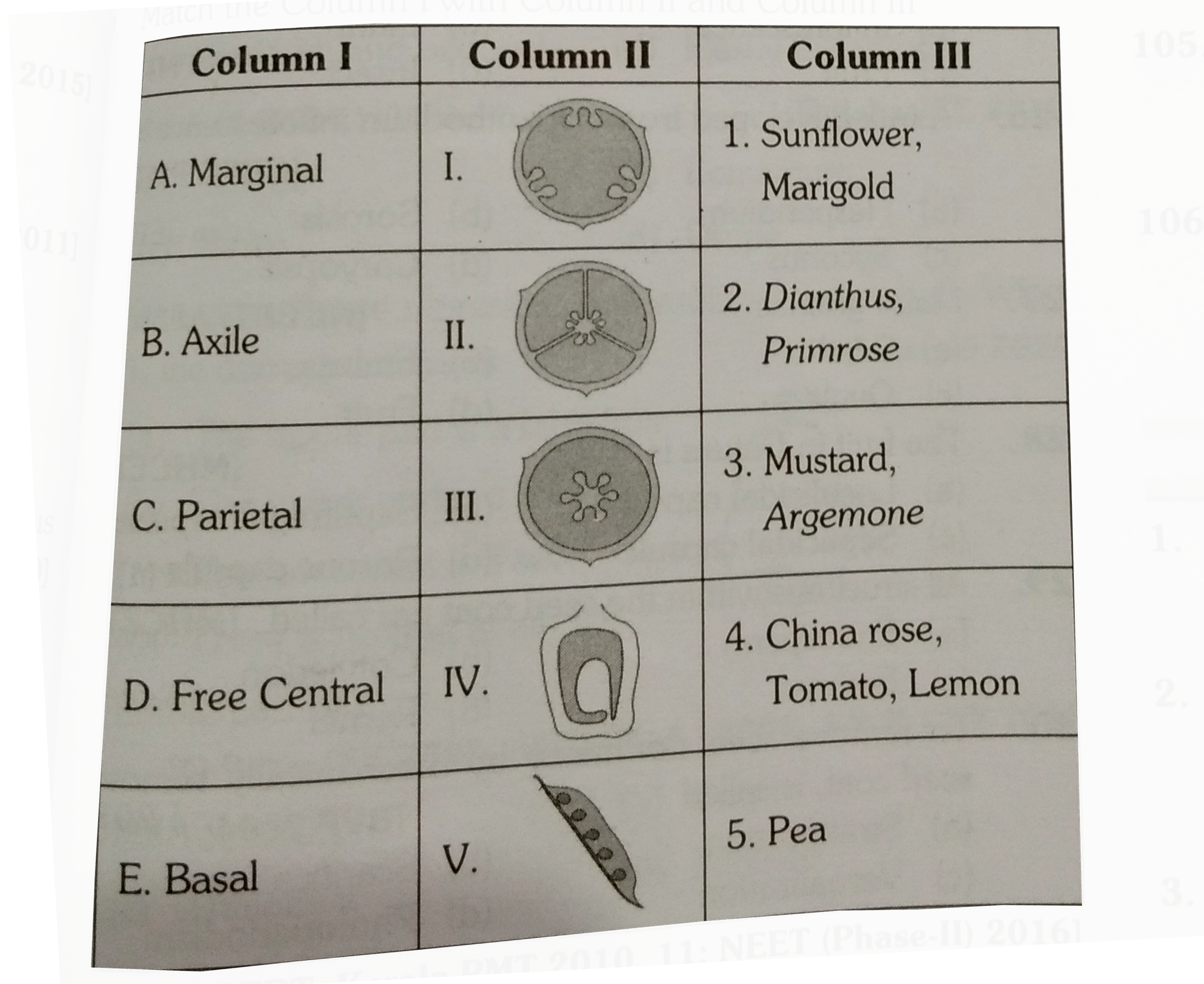 AA−V,1lB−II,2,C−II,4,D−I,5,E−IV,3BA−V,1,B−II,4,C−I,2,D−III,3,E−IV,5CA−I,5,B−II,4,C−III,3,D−IV,2,W−V,1DA−V,5,B−II,4,C−I,3,D−III,2,E−IV,1
AA−V,1lB−II,2,C−II,4,D−I,5,E−IV,3BA−V,1,B−II,4,C−I,2,D−III,3,E−IV,5CA−I,5,B−II,4,C−III,3,D−IV,2,W−V,1DA−V,5,B−II,4,C−I,3,D−III,2,E−IV,1
Match Column I with Column II for the oxidation states of the central atoms .
Column IColumn II(i)Cr2O2−7(a)+3(ii)MnO−4(b)+4(iii)VO−3(c)+5(iv)FeF3−6(e)+7View SolutionMatch the column I with the column II
 View Solution
View SolutionMatch the column I with column II and with column III.
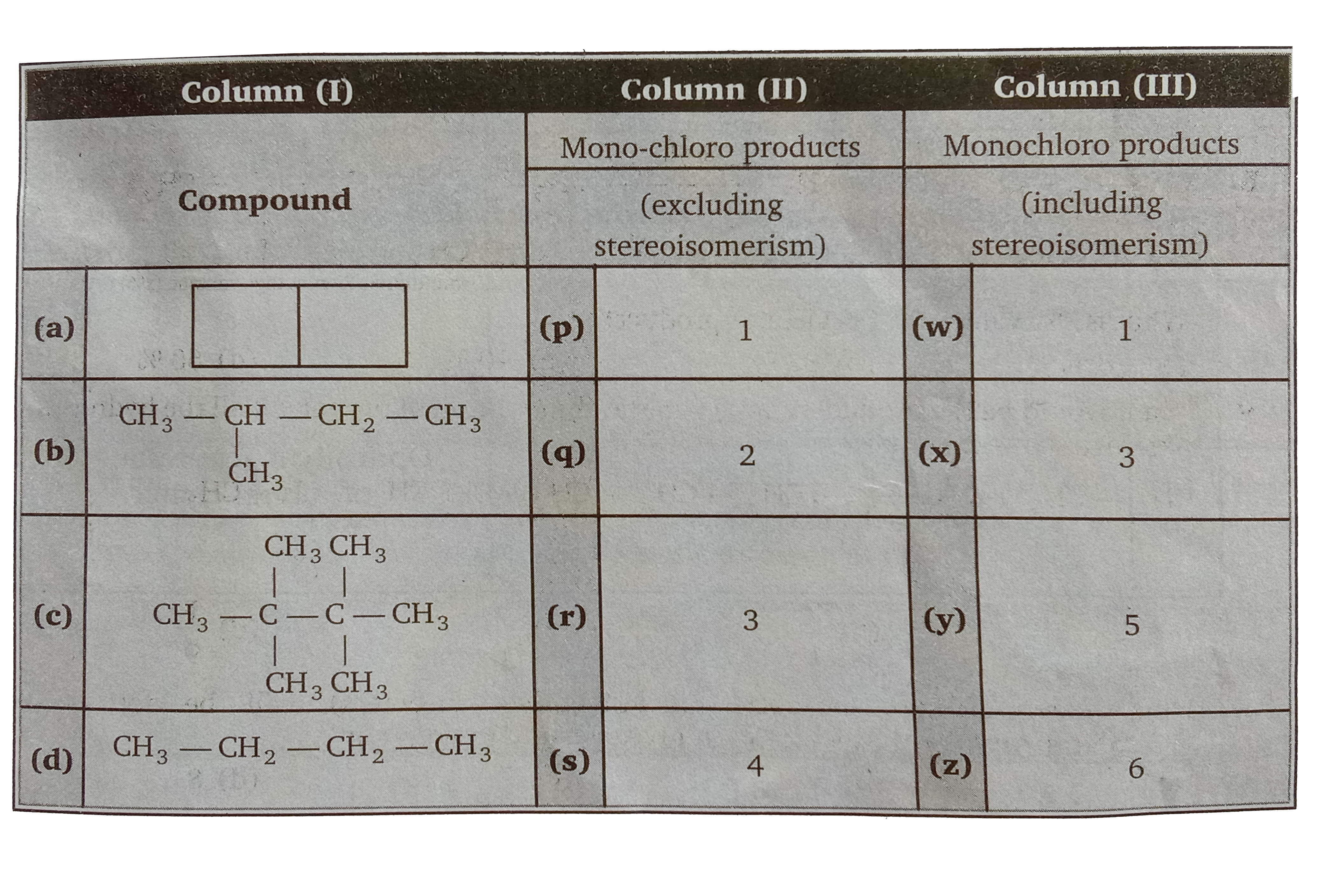 View Solution
View SolutionMatch the column I with column II and with column III.
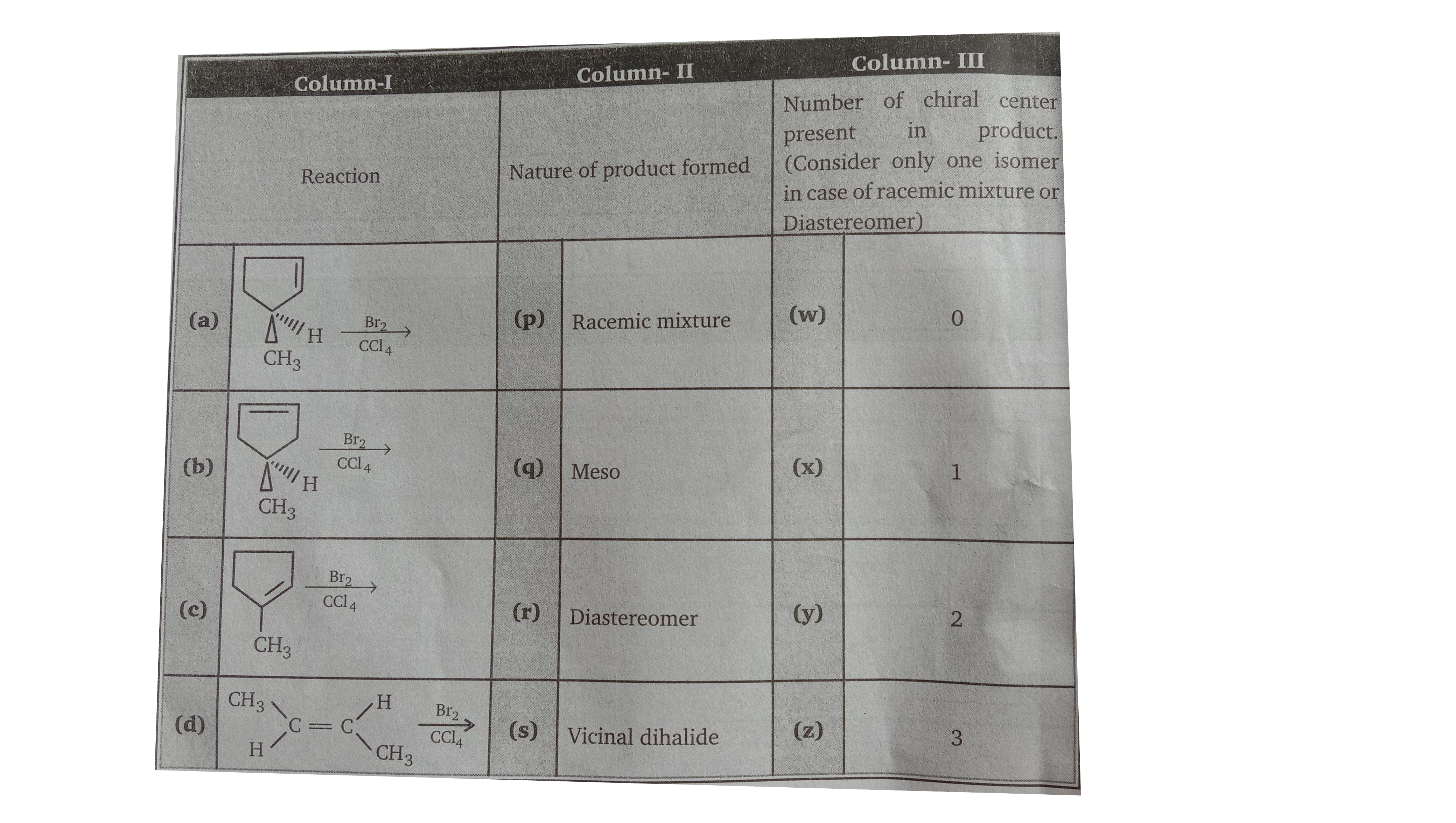 View Solution
View SolutionMatch the column-I and column-II .
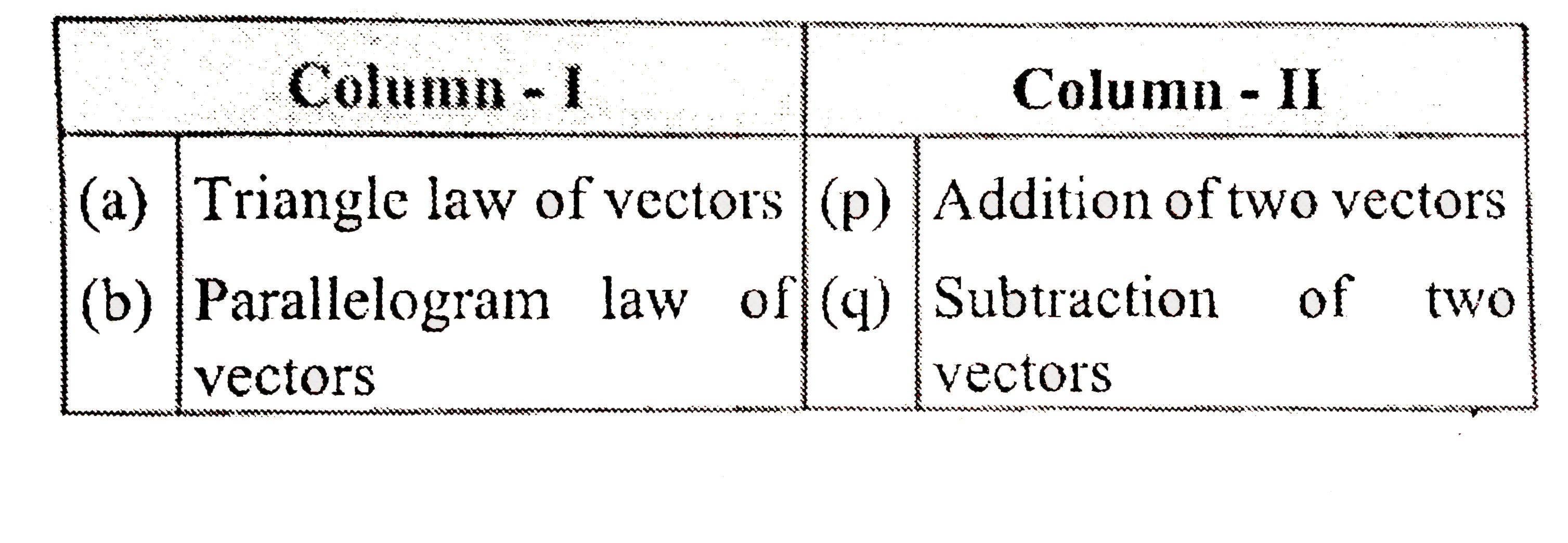
 View Solution
View Solution


